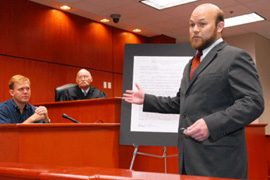Two authors, one copyright
The importance of written agreements in work-for-hire / joint authorship situations
Take a look at the following hypothetical examples:
Situation A. Paul writes some song lyrics and a musical arrangement for vocals, guitar, and bass. He takes his work to his buddy, Ringo, and asks Ringo to compose a drum arrangement for the song.
Situation B. A software designer, Milo, wants to develop a cell phone app. Milo writes most of the code for the app. He makes a handshake agreement to pay $10,000 to Lisa, an independent contractor, for writing one section of code that is critical to the app’s function. Milo tells Lisa that he will put her name on the credits. He also says that he wants her work to be a “work for hire” but he doesn’t put anything in writing and Lisa doesn’t sign anything.
Situation C. Holden writes prose and draws characters for his successful comic book. He asks his BFF, Banky, to “trace over and color in” the images that Holden has drawn in pencil. They both agree that, while inking and coloring is a small part of the creative process, a comic book just isn’t complete unless it has been inked and colored.
In each of these examples, one person contributed significantly more to the creation of the final product. But because the parties didn’t agree to any special split of ownership for the final product, the default provisions of the Copyright Act state that the parties will share equally. Seems like an unfair result, right? That is why it is crucial for people to put a plan in writing before working with others to create a copyrightable work. Putting it in writing ensures that everyone’s expectations are clear and that the default provisions of the Copyright Act don’t come into play.
Note that the phrase “work for hire” has special meaning under U.S. Copyright Law. If the artist (musician, programmer, etc.) creating the work is a contractor/freelancer and the work is referred to as a “work for hire” in a written agreement with the artist, and is signed by that artist, then the hiring party would own the copyright to the work. If the artist is an employee rather than a contractor, the employer owns the copyright to the work the artist creates for the employer even without a signed, written agreement. (Determining whether an artist is considered an employee or a contractor is usually obvious, but there is nonetheless a set of specific factors to rely on to make this distinction.)
Businesses and creatives alike need to be aware of the types of situations that can give rise to the need for a written contract whenever multiple parties are involved in authoring a work. Here are a few situations where conflicts can arise:
- Non-employee consultant creates (or helps create) text or imagery for a business (e.g., marketing materials, website/blog/social media content, product packaging, logos)
- Non-employee photographer captures images of a business’ employees, facilities, or processes that the business intends to use for more than just a print on the wall
- Musicians collaborating on a new song
- Investigators compiling information for a new database
- All work-for-hire situations where a business or individual intends to own any rights in the underlying work created by the hired hand
While the best time to agree to terms is before the joint work is completed, it’s still possible to transfer rights in a joint work after copyright has been established. A post-creation agreement will be more cost-effective and less ulcer-inducing than relying on the court system to allocate rights in the work. Of course, a party that understands the default provisions of the Copyright Act can more effectively leverage its position in any post-creation negotiation of rights.
Freelancers: be you a visual artist, musician, programmer, writer, etc., please understand that if you sign a work for hire agreement, you will not own the rights in the work you create under that agreement!
One final note regarding the default provisions and joint authorship: Few people realize that, in the absence of an agreement, each joint author is able to grant a non-exclusive license to third parties, subject only to an accounting of licensing fees to the other joint authors. This means that one joint author (no matter the percentage of contribution) could exploit the entire created work even if the other joint author(s) don’t agree to the exploitation. Situations such as these tend to be acrimonious and full of distrust, especially when the time comes to account for any money.
The moral of this blog entry (assuming that musings on the law are still allowed to have morals):
WHEN IN DOUBT, WRITE IT OUT!
If you or your company need help navigating the sometimes-murky waters of copyright law, contact Stone & Vaughan, PLLC. Our firm’s attorneys offer up-to-date and cost-effective legal advice on a wide variety of intellectual property matters.
- justin's blog
- Log in to post comments



